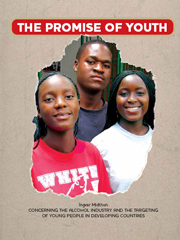
Global Burden of Disease figures show: Alcohol grows as risk factor for death and disability (corrected version)
Alcohol is the leading risk factor for death and disability in Southern sub-Saharan Africa, Eastern Europe and in parts of Latin America. This is one of the conclusions from a new calculation of the Global Burden of Disease. The new study is based on figures from 2010 and these figures are compared to a similar study from 1990.
The new study found that alcohol was the fifth leading risk factor for death and disability globally in 2010, accounting for 3.9% of disability adjusted life years (DALYs) lost globally, up from 3.0% in 1990. 67 risk factors have been studied and results are presented for 21 regions all over the world.
The Global Burden of Disease (GBD) study attempts to calculate which factors cause early deaths and reduced health globally. Such calculations have earlier been presented in 1990 and in 2005. Parallel to the work with the 2010 study the researchers have made a complete re-assessment of the burden of diseases and injuries also in 1990. Consequently, for the first time changes in burden of disease attributable to different risk factors can be analysed over time with comparable methods and figures.
The new material which was launched in London on the 14th of December 2012 and published in a special issue of the journal The Lancet, is based on figures from 2010. After the launch in December 2012 it was discovered that there were some miscalculations in the material. One of these was related to the disease burden caused by alcohol consumption. Figures therefore had to be re-calculated and conclusion re-assessed. Following from this alcohol is now rankes as risk factor number five (and not three as concluded in the first place). This article in ADD Resources is built on the new and corrected figures, and the same is the all material which can be found at the Lancet web site.

- These new figures are yet another argument for the importance of including alcohol prevention efforts into national development strategies in the South, comments Morten Lønstad, Secretary General of FORUT. – Experience shows that an increase in alcohol consumption and related harm often follows economic development in a country. This means that developing countries need to enforce regulations of the alcohol market in order to avoid that successful development efforts come at a high cost in form of increased alcohol problems. As the new Global Burden of Disease figures show the level of alcohol-related harm in particular in Africa and Latin America is already alarmingly high, says Lønstad.
Access the new GBD material at the Lancet web site here.
See also: Alcohol grows as risk factor for death and disability in 2010 GBD Study, by Charles Parry and Jürgen Rehm, The Globe, no. 1 2013
A shifting health picture
The new figures reveal substantial shifts in the burden of disease globally:
- from children to younger adults,
- from premature mortality to morbidity and disability,
- from communicable, maternal, neonatal and nutritional conditions to non-communicable diseases like cancer, diabetes and heart and lung diseases.
After reworking the data to ensure comparability, in 1990 alcohol was ranked as the 8th leading cause of death and disability. Based on 2010 data alcohol is ranked 5th in terms of risk after high blood pressure, smoking, indoor air pollution and low fruit intake. 2010 figures also show that alcohol was the leading risk factor for death and disability in large parts of the world including Southern sub-Saharan Africa, Eastern Europe and most of Latin America. Significantly, almost 3,9 % of disability adjusted life years (DALYs) lost worldwide are attributed to alcohol. Globally, this amounts to 97 million years of life years lost through dying early or living with an alcohol-related disability.
The GBD calculations confirm the strong gender aspect of alcohol consumption and related harm. Among males between 15 and 39 years alcohol use is the leading risk factor for death and disability. This harm includes injuries, violence and cardiovascular diseases that accompany such use. Globally, 6.2% of all male deaths are attributable to alcohol, compared to 1.1% for females. Men also experience a much higher total health burden attributed to alcohol than women do: 7.1% versus 1.4%. The total burden refers to all acute and chronic health problems that can be attributed to alcohol.
- Good reasons for development of alcohol policies

Huge research effort
The Global Burden of Diseases, Injuries, and Risk Factors Study 2010, which is the full title of the new report, presents comparable estimates of mortality, causes of death, years lived with disability (YLDs), and disability-adjusted life years (DALYs). The report covers figures for 291 conditions and 67 risk factors, for 21 regions and three time periods – 1990, 2005, and 2010. The fact that 486 authors from 302 institutions in 50 countries all over the world have contributed to the report, illustrates the magnitude of this scientific effort. At the launch event in London Richard Horton, the editor-in-chief of The Lancet, said that around 650 million calculations have been done in the process leading up to the final results. – The new Global Burden of Disease report is the most comprehensive assessment of global health in the history of medicine.
Relevance for the post-2015 goals
Richard Horton made reference to the ongoing international process to design a new set of sustainability goals to replace the Millennium Development Goals after 2015. – These new goals are about all of us, said Horton. - They challenge us to find common solutions. Horton said the new GBD figures come at a critical time, as they may be useful input to the designing of the new global goals. The burden of disease concept encompasses all types of health issues and not only for risk groups or certain segments of the world’s population.
![]()
![]()
Developed with CustomPublish CMS by Nettinfo AS




